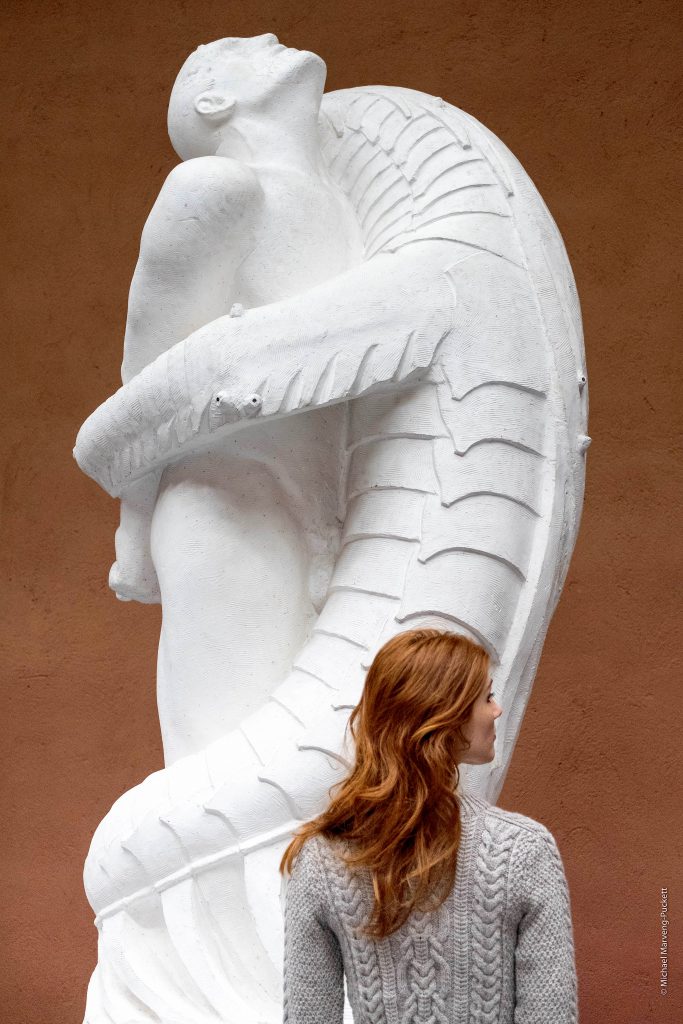 On Monday, I had a photoshoot at the Vigeland Museum, next to the Vigeland Park in Oslo. The brick building, with a majestic ceiling height, was built in the 1920’s in a Norwegian Neo Classical style. “The museum is the result of a unique contract between Gustav Vigeland and the city of Oslo signed in 1921: The Municipality agreed to build a studio, residence and future museum for the artist and his work, and in return Vigeland donated nearly all his works, previous and future, to the city”. It was with anticipation we (read my brilliant team: Photographer Eivind Røhne; Hair & Make Up Artist Sissel Fylling; Model Emma Ross; Michael; and me) were let in by one of the curators, as the museum is closed to the public on Mondays. During the day we had the chance to observe the curators at work and they us. As much as we admired their work, they enjoyed watching the beautiful garments being photographed and wondered which fashion magazine we were from. I explained that I designed handknit and that the photos were for the patterns and for the magazine Familien. Above you see gorgeous model Em, photographed by Michael in front of one of the plaster models for a sculpture to the park. Em is wearing Eira Pullover made for knit.wear Fall/Winter 2017, soon to be released in English in my Ravelry store.
On Monday, I had a photoshoot at the Vigeland Museum, next to the Vigeland Park in Oslo. The brick building, with a majestic ceiling height, was built in the 1920’s in a Norwegian Neo Classical style. “The museum is the result of a unique contract between Gustav Vigeland and the city of Oslo signed in 1921: The Municipality agreed to build a studio, residence and future museum for the artist and his work, and in return Vigeland donated nearly all his works, previous and future, to the city”. It was with anticipation we (read my brilliant team: Photographer Eivind Røhne; Hair & Make Up Artist Sissel Fylling; Model Emma Ross; Michael; and me) were let in by one of the curators, as the museum is closed to the public on Mondays. During the day we had the chance to observe the curators at work and they us. As much as we admired their work, they enjoyed watching the beautiful garments being photographed and wondered which fashion magazine we were from. I explained that I designed handknit and that the photos were for the patterns and for the magazine Familien. Above you see gorgeous model Em, photographed by Michael in front of one of the plaster models for a sculpture to the park. Em is wearing Eira Pullover made for knit.wear Fall/Winter 2017, soon to be released in English in my Ravelry store.
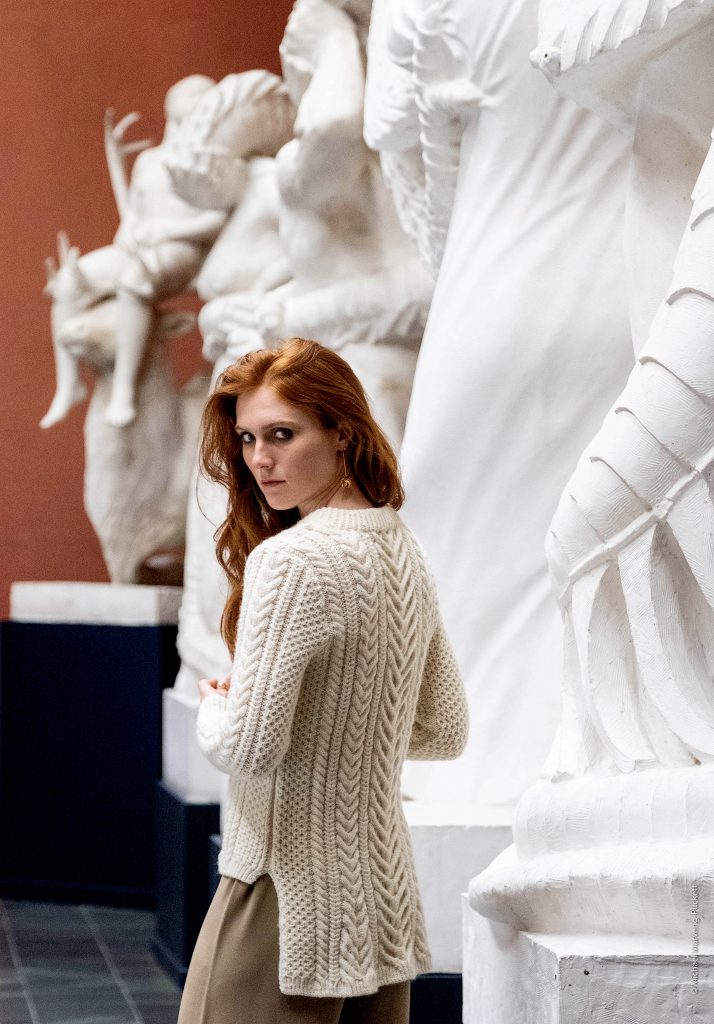 “Vigeland moved into the new building in 1924, living in the apartment on the top floor of the east wing. Here he resided and worked until his death in 1943. From the tower in this majestic red brick building he had a beautiful view towards the fields of Frogner, where his great project, the park, soon was to be reality.” We were guided into the Children’s room, were we would camp out all day. I am sure we enjoyed it as much as the children who usually visit that room! While Hair & Make up Artist Sissel was working her magic on Em, Eivind and I did a round in the museum. We picked two halls as for our shoot: Hall 9, which you see above and the Monolith Hall, which you see below. On the agenda was photographing a total of 10 garments: 4 new designs for Hillesvåg Ullvarefabrikk; 1 new design for the Norwegian magazine Familien: Nemetona; 4 returning designs from Interweave: Eira Pullover, Rørbye Cardigan, White Mountain Ruana and Andaman Top; 1 old design from my book: Tweedjakke with accessories: Duggdråpe Halser.
“Vigeland moved into the new building in 1924, living in the apartment on the top floor of the east wing. Here he resided and worked until his death in 1943. From the tower in this majestic red brick building he had a beautiful view towards the fields of Frogner, where his great project, the park, soon was to be reality.” We were guided into the Children’s room, were we would camp out all day. I am sure we enjoyed it as much as the children who usually visit that room! While Hair & Make up Artist Sissel was working her magic on Em, Eivind and I did a round in the museum. We picked two halls as for our shoot: Hall 9, which you see above and the Monolith Hall, which you see below. On the agenda was photographing a total of 10 garments: 4 new designs for Hillesvåg Ullvarefabrikk; 1 new design for the Norwegian magazine Familien: Nemetona; 4 returning designs from Interweave: Eira Pullover, Rørbye Cardigan, White Mountain Ruana and Andaman Top; 1 old design from my book: Tweedjakke with accessories: Duggdråpe Halser.
 “The museum opened in 1947, houses almost Vigeland’s entire production; sculptures in plaster, granite, bronze, marble, works in wrought iron, thousands of drawings, woodcuts and woodcarvings. In the museum you will find the original plasters to his famous busts and monuments, in addition to the plaster models to the sculptures in the Vigeland Park.” Above you can see Eivind in action, with me standing next to him and Michael just behind him. In the end we photographed nearly all of the garments, with the two exceptions you see above, in the Monolith Hall.
“The museum opened in 1947, houses almost Vigeland’s entire production; sculptures in plaster, granite, bronze, marble, works in wrought iron, thousands of drawings, woodcuts and woodcarvings. In the museum you will find the original plasters to his famous busts and monuments, in addition to the plaster models to the sculptures in the Vigeland Park.” Above you can see Eivind in action, with me standing next to him and Michael just behind him. In the end we photographed nearly all of the garments, with the two exceptions you see above, in the Monolith Hall.
The lizard in wrought iron is a model for the gates in the Vigeland Park and the most complicated of these wrought iron works Vigeland made. Their graphical presence added extra drama and was perfect for the Tweedjakke worn over Judith Bech’s wonderful skirt with a train. I was wearing the Patent Poncho, while Sissel – as you can see was cold – and wore her coat inside. To our surprise she did not cut Em’s hair this time. I had also borrowed jewellery by Kaja Gjedebo Design, as I usually do. There is no café at the museum so I had ordered catering from the nearby Eckers Cafe, with one delivery of drinks in the morning and one for lunch, so that we would not loose too much time looking for a nearby restaurant and wait for our lunch. That worked well and while we spent quite a bit of time to set up and prepare for the first garment, the remaining ones went quickly.
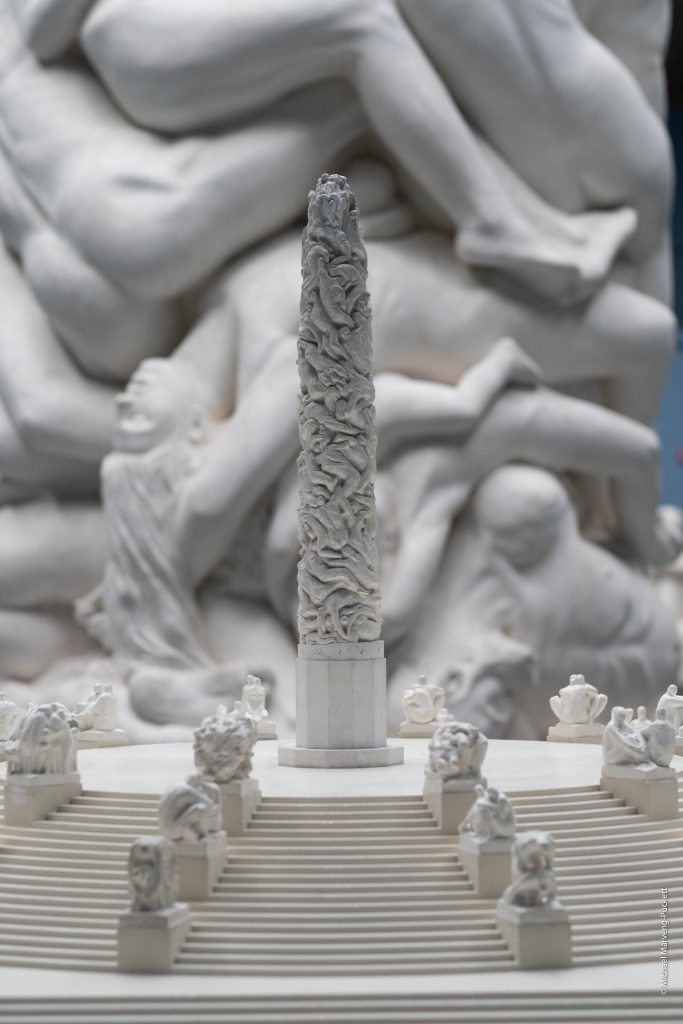 Michael assisted Eivind but also had the time to photograph some of the collection in the museum. Eivind had brought both extra lighting and a huge flash to make sure the lighting would be good enough. Above is the Monolith model for the park in front of the Monolith itself. “In the Monolith Hall stand several of the original plaster models to the 36 granite sculptures on the Monolith plateau, as well as the Monolith itself. This sculpture was carved in one piece (hence the name Monolith), but it was first modelled in clay, and then casted in plaster in three parts, as displayed in the museum today.”
Michael assisted Eivind but also had the time to photograph some of the collection in the museum. Eivind had brought both extra lighting and a huge flash to make sure the lighting would be good enough. Above is the Monolith model for the park in front of the Monolith itself. “In the Monolith Hall stand several of the original plaster models to the 36 granite sculptures on the Monolith plateau, as well as the Monolith itself. This sculpture was carved in one piece (hence the name Monolith), but it was first modelled in clay, and then casted in plaster in three parts, as displayed in the museum today.”
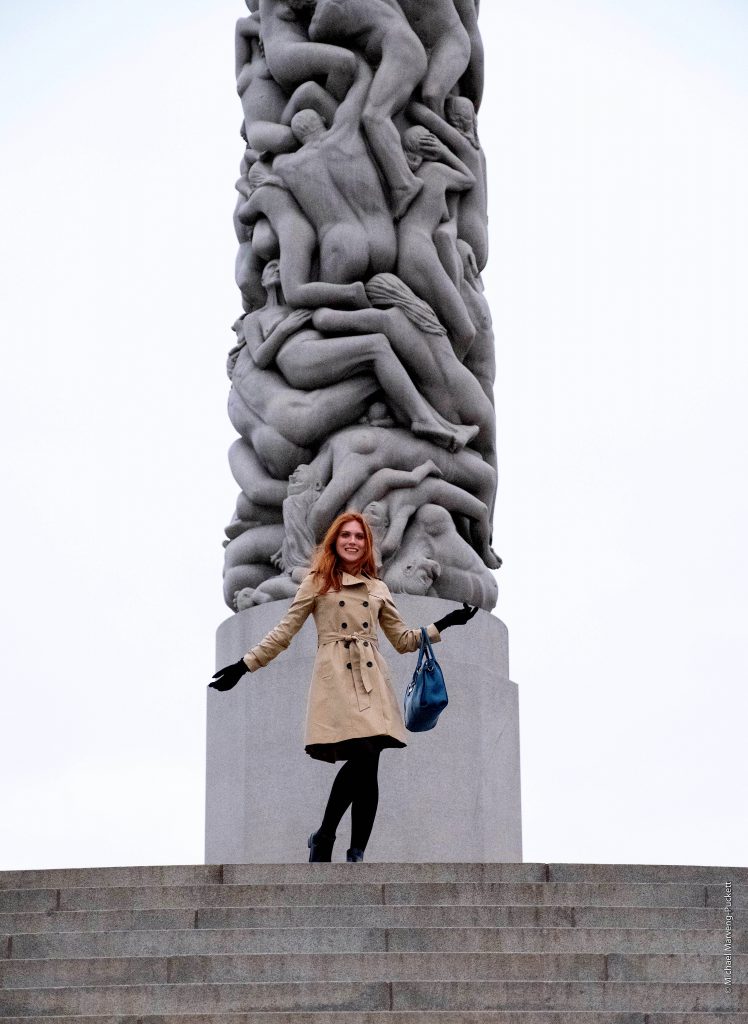 The Vigeland Museum is a popular venue for fashion shows, but also for concerts outside in the courtyard during the summer. The photoshoot was exhausting but also extremely rewarding and wonderful at the same time! After the shoot was a wrap – thanks to a brilliant team – and we had taken farewell with the curators and the security officer, we headed for the park, as Em has not had the time previously to see it. Above you see here in front of the Monolith in granite. Do visit both the park and the museum, when in Oslo, they are worth it. I will recapture our visit by choosing pictures from Eivind.
The Vigeland Museum is a popular venue for fashion shows, but also for concerts outside in the courtyard during the summer. The photoshoot was exhausting but also extremely rewarding and wonderful at the same time! After the shoot was a wrap – thanks to a brilliant team – and we had taken farewell with the curators and the security officer, we headed for the park, as Em has not had the time previously to see it. Above you see here in front of the Monolith in granite. Do visit both the park and the museum, when in Oslo, they are worth it. I will recapture our visit by choosing pictures from Eivind.

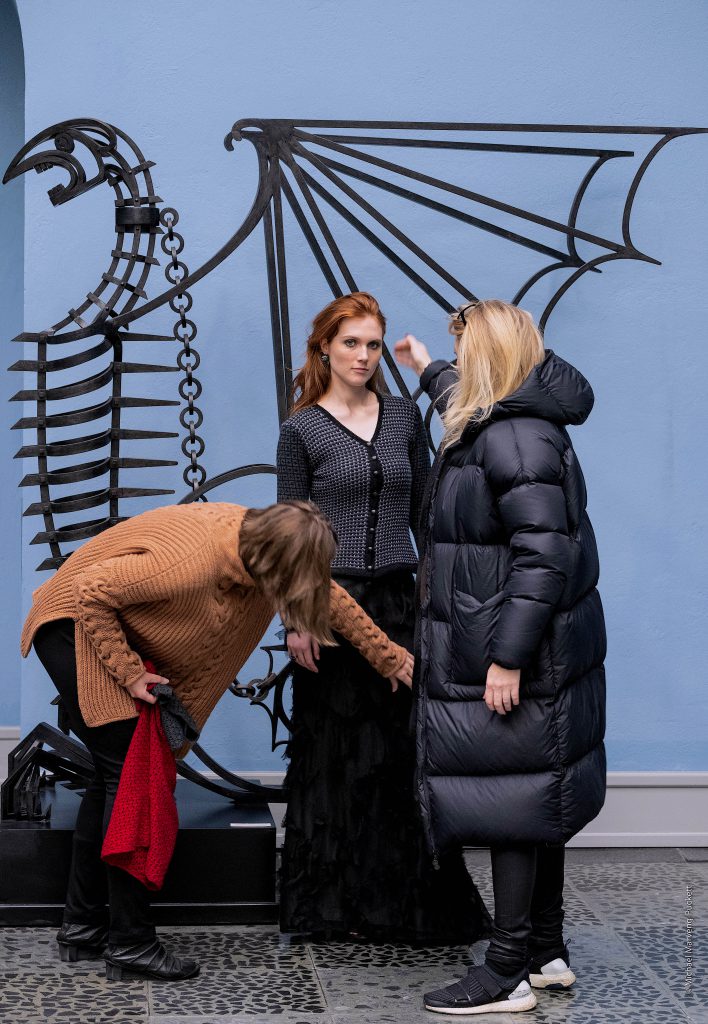
Pingback: Photoshoot at Vigeland Museum: Nemetona | Linda Marveng
Pingback: Photoshoot at Vigeland Museum: Eira Pullover | Linda Marveng
Pingback: Photoshoot at Vigeland Museum: Rørbye Cardigan | Linda Marveng
Pingback: Photoshoot at Vigeland Museum: White Mountain Ruana | Linda Marveng
Pingback: Photoshoot at Vigeland Museum: Corra | Linda Marveng
Pingback: Behind the Scenes: Photoshoot at Oslofjord Museum | Linda Marveng